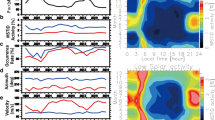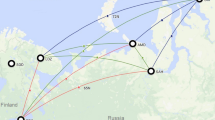Abstract
A comprehensive study on the anomalous propagation (AP) conditions occurring over the central and west African stations was made from 2 years (January 2005–December 2006) high-resolution data measured by GPS (Global Positioning System) radio survey observations. Through data quality control and diagnostic analysis, the probability of AP occurrence and characteristic quantities of the three typical anomalous propagation conditions were given. The sub-refraction, super-refraction and ducting cases were investigated statistically using the vertical profile of modified refractivity gradient. Strong diurnal variation in the percentage occurrence of the AP had its peak during the wet months, while the dry months had the lowest values. From 0600 to 1800 local time (LT) at day (1800–0600 LT at night), the total percentage occurrence of super-refraction, sub-refraction and ducting were 82.5% (78.5%), 11% (15.5%) and 6.5% (6%), respectively. Besides statistical results, local meteorological conditions prevailing over central and west Africa have also been discussed.
Highlights
-
Seasonal maps of occurrence of sub-refraction, super-refraction and ducting layers have been constructed.
-
The daytime (0006–1800 local time) is seldom affected by ducting as a result of the ceaseless and intense heat activity.
-
The refractivity index was obtained from in-situ measurements performed at the 19 stations.
-
Sub-refractive prevails at daytime whereas super-refractive and ducting are observed at night time (1800–0006 local time).















Similar content being viewed by others
References
Ao C O 2007 Effect of ducting on radio occultation measurements: An assessment based on high-resolution radio survey; Radio Sci. 42 RS2008, https://doi.org/10.1029/2006rs003485.
Babin S M 1996 Surface duct height distributions for Wallops Island, Virginia, 1985–1994; J. Appl. Meteorol. 35 86–93.
Barla M C 1986 Sur les indices de réfraction atmosphérique en Turquie; La Météorologie. VII 13 2–6.
Bean B R and Dutton E J 1996 Radio-meteorology; Dover Publishers, New York, 435p.
Bech J, Codina B and Lorente J 2007 Forecasting weather radar propagation conditions; Meteorol. Atmos. Phys. 96 229–243.
Bech J, Codina B, Lorente J and Bebbington D 2002 Monthly and daily variations of radar anomalous propagation conditions: How ‘normal’ is normal propagation? In: Proceedings of Second European Conference of Radar Meteorology, Delft, Netherlands; ERAD Publ. Ser vol. 1, Copernicus GmbH, pp. 35–39.
Cheng Y, Shengqi Z, Dongxiao W, Yuanzheng L and Jinglong Y 2015 Statistical characteristics of the surface ducts over the South China Sea from GPS radio survey data; Acta Oceanol. Sin. 34 63–70.
Dalmaz M 1977 Variation de la réfraction atmosphérique en fonction de la température á Göztepe; La Météorologie. VI 10 113–124.
Faccani C, Rabier F, Fourrie N, Agusti-Panareda A, Karbou F, Moll P, Lafore J P, Nuret M, Hdidou F and Bock O 2009 The impacts of AMMA radio survey data on the French global assimilation and forecast system; Wea. Forecasting, https://doi.org/10.1175/2009waf2222237.1.
Falodun S E and Ajewole M O 2006 Radio refractive index in the lowest 100-m layer of the troposphere in Akure, southwestern Nigeria; J. Atmos. Sol. Terr. Phys. 68(2) 236–243.
Falodun S E and Okeke P O 2012 Radio wave propagation measurements in Nigeria (preliminary reports); Theor. Appl. Climatol. 113 127–135.
Fink A H, Agusti-Panareda A, Parker D J, Lafore J P, Ngamini J B, Afiesimama E, Beljaars A, Bock O, Christoph M, Didé F, Faccani C, Fourrié N, Karbou F, Polcher J, Mumba Z, Nuret M, Pohle S, Rabier F, Tompkins A M and Wilson G 2010 Operational meteorology in west-central Africa: Observational networks, weather analysis and forecasting; Atmos. Sci. Lett. 12 135–141.
Freehafer J E 1988 Tropospheric refraction; In: Propagation of short radio waves (ed.) Kerr D E, Peninsula Publishing, pp. 9–22.
Guy N, Rutledge S and Cifelli R 2011 Radar characteristics of continental, coastal, and maritime convection observed during AMMA/NAMMA; Quart. J. Roy. Meteorol. Soc. 137 1241–1256.
Kaissassou S, Lenouo A, Nzeukou A, Tchawoua C and Vondou D 2015a Seasonal variations of surface duct conditions in Ngaoundere, North Cameroon; Meteorol. Atmos. Phys. 127, https://doi.org/10.1007/s00703-015-0387-z.
Kaissassou S, Lenouo A, Tchawoua C, Lopez P and Amadou T 2015b Climatology of anomalous propagation radar over west-central Africa; J. Atmos. Sol.-Terr. Phys. 123 1–12.
Lavergnat J and Sylvain M 2000 Radio wave propagation; In: Principles and Techniques, John Wiley and Sons, New York, ISBN:047149027x.
Lopez P 2009 A 5-year 40-km-resolution global climatology of super refraction for ground-based weather radars; J. Appl. Meteorol. Climatol. 48 89–110.
McGregor G R and Nieuwolt S 1998 Tropical climatology; 2nd edn, Wiley, Chichester, 339p.
Mentes S and Kaymaz Z 2007 Investigation of surface duct conditions over Istanbul, Turkey; J. Appl. Meteorol. Climatol. 46 318–337.
Ojo O 1977 The climates of west Africa; Heinneman, London, pp. 60–72.
Parker D J, Burton R R, Diongue-Niang A, Ellis R J, Felton M, Taylor C M, Thorncroft C D, Bessemoulin P and Tompkins A M 2005 The diurnal cycle of the west African monsoon circulation; Quart. J. Roy. Meteor. Soc. 131 2839–2860.
Parker D J, Fink A, Janicot S, Ngamini J B, Douglas M, Afiesimama E, Panareda A A, Beljaars A, Dide F, Diedhiou A, Lebel T, Polcher J, Redelsperger J L, Thorncroft C and Wilson G A 2008 The AMMA radio survey program and its implications for the future of atmospheric monitoring over Africa; Bull. Am. Meteorol. Soc., https://doi.org/10.1175/2008bams2436.1.
Steiner M and Smith J A 2002 Use of three-dimensional reflectivity structure for automated detection and removal of non-precipitating echoes in radar data; J. Atmos. Oceanic Technol. 19 673–686.
Tapio S, Tobias B and Gerald H 2014 Migrations and dynamics of the inter-tropical convergence zone; Nature Geosci. 513, https://doi.org/10.1038/nature13636.
Turton J D, Bennetts D A and Farmer S F 1988 An introduction to radio ducting; Meteor. Mag. 117 245–254.
Willoughby A A, Aro T and Owolabi I E 2002 Seasonal variations of radio refractivity gradients in Nigeria; J. Atmos. Sol.-Terr. Phys. 64 417–425.
Zribi M, Sahnoun M, Baghdadi N, Le Toan T and Hamida A 2016 Analysis of the relationship between backscattered P-band radar signals and soil roughness; Remote Sens. Environ. 186 13–21.
Acknowledgement
Our sincere appreciation goes to AMMA for providing the radio survey data used for the analysis in our work (http://www.amma-international.org).
Author information
Authors and Affiliations
Contributions
Samuel Kaissassou developed code, designed, performed and analysed the simulation experiments and prepared the manuscript with contributions from all co-authors. A Lenouo, A Vondou, R Tanessong, and W Pokam supervised the research, co-designed the experiments and reviewed the manuscript. K Tamo and J Kanko performed figures and quality control of data.
Corresponding author
Additional information
Communicated by Suresh Babu
Rights and permissions
About this article
Cite this article
Kaissassou, S., Lenouo, A., Tanessong, R.S. et al. Investigation of anomalous propagation conditions in Central and West African stations using high-resolution GPS radiosonde observations. J Earth Syst Sci 129, 220 (2020). https://doi.org/10.1007/s12040-020-01477-y
Received:
Revised:
Accepted:
Published:
DOI: https://doi.org/10.1007/s12040-020-01477-y




